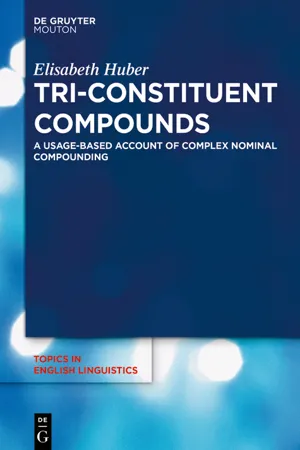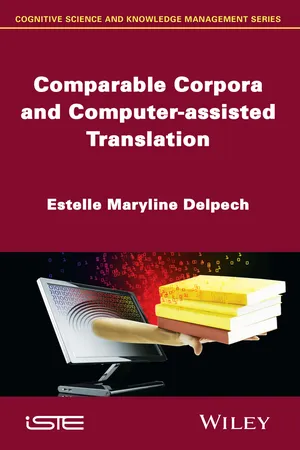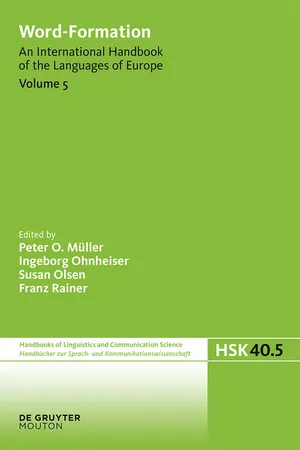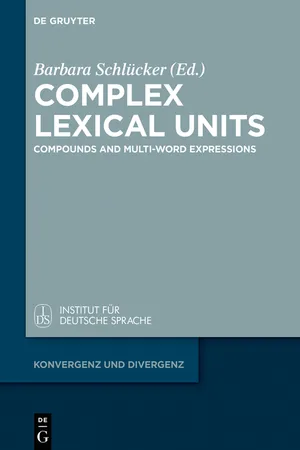Languages & Linguistics
Compounding
Compounding refers to the process of combining two or more words to create a new word with a distinct meaning. In linguistics, compounding is a common method of word formation found in many languages. It involves joining together individual words to form a single unit, often resulting in a compound noun, adjective, or verb.
Written by Perlego with AI-assistance
5 Key excerpts on "Compounding"
- eBook - ePub
Tri-Constituent Compounds
A Usage-Based Account of Complex Nominal Compounding
- Elisabeth Huber(Author)
- 2023(Publication Date)
- De Gruyter Mouton(Publisher)
Bauer (2017) . The following sections will define the phenomenon of Compounding (Section 2.1), summarize the most important aspects related to this word-formation process (Section 2.2) and explain the understanding of Compounding in this project (Section 2.3). As this work focusses on compounds consisting of three nouns, the explanations will mostly be limited to noun compounds.2.1 What is a compound?
Compounding describes the formation of a new lexeme by adjoining two or more existing lexemes (Bauer 1983a : 28; Adams 2001 : 2). This is presumably the definition that is most concise, with the cost of not being fully precise regarding the input items. It is mostly lexemes that are combined in Compounding; however, the elements of compounds can also be blocked morphemes or combining forms (cf. Schmid 2016 : 127–130). Although consisting of lexemes, constructions like jack-in-the-box are generally not counted under the category of compounds, following the “no-phrase constraint”, which determines that complex words are not formed from explicit syntactic phrases (Adams 2001 : 3).The output of the process of Compounding is a new lexeme, i.e. a complex word that functions like a single word (Quirk et al. 1985 : 1567). Behaving like a single word in a grammatical sense has several implications concerning the modification of a compound, its interruptability, the substitutability of its constituents and its possibilities regarding co-ordination (cf. Bauer 2017 : 15–25). A combination of two words is categorized as one word if it is not separable, i.e. it can only be relocated as a whole in a syntactic context and cannot be rearranged or interrupted with other words or inflectional morphemes. This implies that compounds are inflected as a whole, i.e. the plural is formed on the right-most element (e.g. bus drivers, *busses driver). If a compound is modified, the modifier refers to the whole combination and not just the first constituent (e.g. in old bus driver, the adjective old does not describe bus but bus driver). As opposed to syntactic formations, a compound can usually not be used in a coordinative structure in which the right-most element is replaced by one (e.g. I bought a blue shirt and a green one vs. *I know a cab driver and a bus one). For a discussion of these aspects including exceptions see Bauer (1998) .1 - eBook - ePub
- Henry Bradley(Author)
- 2013(Publication Date)
- Dover Publications(Publisher)
IVWord-Making in English
The English language has augmented its resources not only by the adoption of words from other tongues, but also by the making of new words. There are three possible ways in which a new word can be made: (1) by Composition, which means the joining together of two existing words to form a compound; (2) by Derivation , which means the making of a new word out of an old one, usually by the addition of some prefix or suffix which is not itself a word, but is significant in combination; and (3) by Root-creation , which is the invention of an entirely new word, usually either imitative of some inarticulate noise, or suggested by some instinctive feeling of expressiveness.1. COMPOSITION.
A compound word is a word formed by joining two or more words to express a meaning that could be rendered by a phrase of which the simple words form part. Some languages have no compound words at all; and those which have them do not all form them after the same manner. The principles of English word-Compounding are, to a great extent, inherited from the primitive Indo-Germanic language. In those kinds of compounds that most frequently occur, the last element expresses a general meaning which the prefixed element renders less general. Thus an apple-tree is a tree, but only a particular kind of tree. In the original Indo-Germanic language the prefixed element in a compound of this sort was not, properly speaking, a word , but a word-stem: that is to say, a word deprived of those grammatical characters—case, number, gender, mood, tense, person, etc., which it would possess if it occurred separately in a sentence.19 It has still this character, so far as meaning is concerned, in those English compounds that are formed on the inherited pattern. Thus apple - in apple-tree is neither singular nor plural, neither nominative, accusative, nor genitive. Hence the phrase for which such a compound is the condensed expression admits of great variety of form; the former of the two words may occur in it in any case or in either number; and the meaning of the compound varies accordingly. A tree-frog is a frog that lives in trees; a tree-fern is a fern that is a tree; a tree-fruit is the fruit produced by a tree. As a general rule, our knowledge of the things denoted by the simple words guides us at once to a correct understanding of the meaning of the compound. This, however, is not always the case. A house-boat - Estelle Maryline Delpech(Author)
- 2014(Publication Date)
- Wiley-ISTE(Publisher)
Beyond the question of fertility, the proposed translation generation method will not be limited to the small morphological structures as is the case in [CAR 09b]’s work (only prefixed words), [HAR 12]’s work (only neoclassical compounds) and [WEL 11]’s work (noun and neoclassical compounds). The following section provides a detailed list of the morphological structures that we will endeavor to deal with.4.3.2. Dealing with diverse morphological structures
Contrary to other compositional approaches based on morphological decomposition, the translation method which we present tries not to limit itself to a small set of structural equivalences between source and target language (prefixed → prefixed, word compound → phrase, neoclassical compound → neoclassical compound).The entry is a morphologically complex word. This word can be built by prefixation “pretreatment ”, neoclassical Compounding “densitometry ”, suffixation “childless ”, word Compounding “anastrozole-associated ” or any combination of these four word formation processes. The output of the translation system is a list of n words which can be morphologically complex or not. For example, postoophorectomy can be translated as postovariectomie, après l’ovariectomie or après l’ablation des ovaires .We now describe the four word formation processes and illustrate them with examples of English → French translations taken from the terminology database TERMIUM8 and the bilingual concordancer LINGUEE.94.3.2.1. Word Compounding composition
A word compound is the result of a juxtaposition of two or several words. Sometimes, a hyphen emphasizes the border between the words, and sometimes they are glued to one another.10 With time and use, it is usual for the compositional meaning of compound words to lose its transparency to speakers. For example, the French term for “sprinkle” is “saupoudrer ” which is made from sau , an old variation of sel (salt) and poudrer (to powder).11 We then talk about demotivation . One of the difficulties in popular compound translation is that they are generally composed to become a new meaning unit and may very well not have a compositional meaning, such as for example, a lounge chair- eBook - ePub
- Peter O. Müller, Ingeborg Ohnheiser, Susan Olsen, Franz Rainer(Authors)
- 2016(Publication Date)
- De Gruyter Mouton(Publisher)
section 3.5 , as well as Ralli and Stavrou 1998 and Ralli 2013a).Finally, it should be noted that the well-known neoclassical formations of most European languages (e.g., ánθropoloγía ~ anthropology , imisferio ~ hemisphere , etc.) are compounds, since they obey the laws of Greek Compounding. Many of them are calques, which are fully integrated into the Greek morphological system in that they combine stems, and bear Greek affixes and inflection. For instance, the English term neology has been reformulated in Greek as neoloγía , where the stems ne - ‘young’ and -loγ - ‘doctrine about language’ are linked to each other by the compound marker -o -, and the combination as a whole accepts the derivational affix -ia (there is no overtly realized inflectional suffix in this example). Crucially, as observed by Ralli (2008b), the neoclassical type of formations is formed productively in Greek, as proven by the large number of neologisms appearing each day in the media. A considerable number of them belongs to synthetic compounds, which contain deverbal bound stems, i.e. stems that cannot be free with the presence of inflectional affixes (see section 3.4 ).3. Composition
Compounding as a very productive word-formation process of the Greek language is attested since Homeric Greek (Tserepis 1902). It produces compounds belonging to the major grammatical categories of nouns, adjectives and verbs. Nouns display combinations of two nouns (e.g., kreataγorá ‘meat market’ ← kréa(s) ‘meat’ + aγorá ‘market’) and adjective and noun (e.g., asximópapo ‘ugly duckling’ ← ásxim(o) ‘ugly’ + pap(í) ‘duck’). Adjectives combine two adjectives (e.g., ikonomikopolitikós ‘economic-political’ ← ikonomik(ós) ‘economic’ + politikós ‘political’), a noun and an adjective (e.g., laomísitos ‘hated (by the) people’ ← la(ós) ‘people’ + misitós ‘hated’), or an adverb with an adjective (e.g., aδikoxaménos ‘lost in vain’ ← áδik(a) - eBook - ePub
Complex Lexical Units
Compounds and Multi-Word Expressions
- Barbara Schlücker(Author)
- 2019(Publication Date)
- De Gruyter(Publisher)
Section 3.2 ). For a constructionist analysis for quasi-noun incorporation in Dutch, see Booij (this volume).3.7Discussion
This section is devoted to a discussion and summary of the preceding sections. The first, very simple observation is that all languages examined here have morphological compounds. However, it turned out that the compounds in these languages do not all share the same defining properties. While lexical (compound) stress, headedness (either right or left), inseparability and debarment of word-internal inflection, recursiveness, and linking elements are generally considered essential criteria for the definition of compound, in particular from a German(ic) perspective, all of them also emerged as problematic in at least one language, or as non-existent.27 Thus, it seems that there is no universal definition of compound. Rather, as pointed out by Ralli (2013b: 184):What makes a compound morphological should be defined on a language-specific basis, since languages vary with respect to the realization of their morphological features and the use of morphologically-proper units.Although it is ultimately impossible to weigh the various criteria against each other, it seems that Compounding in German is – hardly surprisingly given the genetical relation – particularly similar to Dutch as well as the continental North Germanic languages, but also to Greek.In addition to the defining criteria, also the number of compound subpatterns and the productivity of these patterns vary considerably between the languages. Verbal Compounding, for instance, is regarded as either unproductive or only marginally productive in most languages, in contrast however to Greek which has several productive verbal compound patterns. What all languages discussed here have in common is that nominal Compounding, and in particular N+N Compounding, is considered the most frequent and probably also the most productive compound type (cf. likewise Guevara/Scalise 2009 for a much larger language sample).
Index pages curate the most relevant extracts from our library of academic textbooks. They’ve been created using an in-house natural language model (NLM), each adding context and meaning to key research topics.
Explore more topic indexes
Explore more topic indexes
1 of 6
Explore more topic indexes
1 of 4




